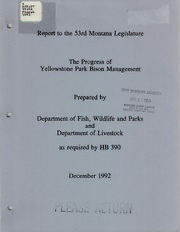
The progress of Yellowstone Park bison management PDF
Preview The progress of Yellowstone Park bison management
s 1 639.97 97358 F2pypb 1992 L j Report to the 53rd Montana Legislature The Progress of Yellowstone Park Bison Management mTJEDOCUMENTSCOLLECT! Prepared by C^> 131993 hMO^NT^AN5A^stataVeaLV/IBoRcAf2toy Department of Fish, Wildlife and Parks and Department of Livestock as required by HB 390 December 1992 W 4 i-jK -««'-iasa j '4X Wt L rcB ; V 1997 OCT16 1097 NOV18 1997 APR2^1959 BACKGROUND The52ndMontanaLegislatureadoptedHouseBill390. Thislegislationeliminatedthesaleof specialwildbuffalohuntinglicenses,whileestablishing:(1)thebisonasagamespeciesinneed ofmanagement;and(2)managementdutiesfortheDepartmentsofFish,WildlifeandParks (FW&P)andLivestock(DOL). Inaddition,HB390urgedtheStateofMontanaandtheNationalParkService(NPS)toenter intoanagreementforlong-termmanagementofYellowstoneNationalPark(YNP)bisonand requiredthatabisonmanagementprogressreportbesubmittedtothe53rdLegislature. Accordingly, MontanacontinuestoworkwithYNPandGallatinNational Forestofficialsto developaplanthatwill: (1)preventthetransmissionofbrucellosisfrombisontodomestic livestock,and(2)controlbisonnumbersinanappropriatemanner. BecausemanagementofYNPbisonisaninternationalissue,thetaskisnotasimpleone. Public debatehasfocusedprimarilyonthreemattersofconcern:(1)regulationofbisonnumbers,(2) diseasecontrol,and(3)hunting. HB390alsosuspendedbisonhuntinginMontanawhichwasfirstestablishedin 1985. Well- organizedandvehementanti-huntingactivitiesraisedconcernsoverthesafetyandwelfareof hunters. The need to provide increased security and to address growing media attention increasedthecostsofthecontrolprogram. Theinternationalmediaattentionalsofueledthe anti-huntingmovement’sfund-raisingdrivesandwasusedtodamagetheimageofhuntersand sporthunting. HB390aided themanagementplanprocessbyshiftingtheheatedpublicdebateawayfrom huntingandtotheheartoftheproblem: theover-populationofbisoninYNPandtheneedto controlbrucellosis,adiseasethataffectsthereproductivecapabilityofdomesticcattleandcauses ungulatefeverinhumans. The appropriateness of the bison hunt remains a matter of controversy among many of Montana’ssportsmenandsportswomen. Thisisoneofmanyissuesthatwillbeaddressedin themanagementplan. However,duringthe1991-92migrationofbisonfromYNPtoMontana, bisonwerecontrolledbystateandfederalofficialsandthescantmediaattentionpaidtocontrol effortstendedtofocusonproblemsassociatedwithdiseasecontrolandtheover-populationof bisoninYNP. INTERIMMANAGEMENTPLAN TheInterimBisonManagementOperatingPlanforthewinterof1990-91wasadoptedbyYNP, GallatinNationalForest,FW&P,andDOL. Theinterimplanwasineffectin1991-92andwill remainineffectuntilalong-termplanisapproved. Montanahasathreefoldinterest in thecontrolofYNPbison: (1)topreventthespreadof brucellosistodomesticcattle; (2)toreducedamagetopersonalproperty; and (3)to reduce threatstohumanhealthandsafety. TheInterim Bison ManagementPlan defines specificresponsibilities for YNP, FW&P, and DOL. Amongtheresponsibilitiesoutlinedintheinterimplanare: mediarelationsandpublic information;monitoringbisonactivity;hazingbisonbackintoYNP;shootingbison;analyzing bloodandtissuesamples;andmore. Asanaddendumtotheinterimplan,agreementswereestablishedwiththeNorthernCheyenne TribeandotherMontanaIndiantribes. Theseagreementsauthorizetribalparticipationinfield dressing carcasses, transporting and distributing bison meat to tribal members. On the reservations,IndianHealthServicesdistributesthefoodtothoseinneed. COURTCHALLENGE Montana’sauthoritytocontrolbisonandthelegalityoftheInterimBison ManagementPlan werechallengedinfederalcourtbytheFundforAnimals,ananti-huntingandanimalrights organization. The District Court ruled that the interim plan complied with the National Environmental PolicyActandthatMontanaindeedhadtheauthoritytocontrolbison. The DistrictCourt’sdecisionwassuccessfullydefendedintheNinthCircuitCourtofAppeals. MANAGEMENTCOSTSANDREVENUES ExpendituresforimplementingtheInterimBisonManagementPlanvarydependingupon:(1) thefrequencyandnumberofbisonmovingfromYNP;and(2)thecooperativeeffortsofNPS andIndianreservationofficials. Revenuesalsovarydependingonthenumberofbisonsoldat publicauction. In1991-92,FW&P’sdirectandindirectbison-controlcostswereabout$55,000. These costs, however, were offsetby the sale ofbison carcasses, heads, and hides which generatedabout$58,000inrevenue. Some170bisonwereprocessedbyMontanaIndiantribes andanadditional 100bisonwereauctionedtothepublicatFW&PfacilitiesinBozemanand Helena. Bycomparison,eventhoughresidentspaid$200andnonresidentspaid$1,000toparticipatein Montana’sbison-controlefforts,between1988and1990—whenmorethan600bisonwerekilled byhunters-Montana’sbison-controlactivitiescostthestateabout$200peranimal,overand abovelicenserevenues. Thesecostswerealsoincreasingduetotheneedforsecuritytoensure publicsafetyandtooverseemediainterests. DOLexpenditures,meanwhile,totaledabout$37,000. Thesecostswereincurredprimarilyfor samplingbisonforbrucellosis,includingsomecostsforbutchering. 2 RULEMAKING HB390requiredFW&Ptodeveloprulesfor:(1)aprogramdesignedtomanagewildbisonthat threatenpropertyorpersonsinMontana;and(2)tomanageandreducethenumberofwildbison thatleaveYNP. Inaddition,HB390requiredDOLtoregulatewildbisonthatposeadisease threattopersonsorlivestock. FW&P’sparticipationinbison-controleffortscontinuestobecarriedoutunderexistinggame damage authority. Additional rules, ifnecessary, will be developed when the long-term managementplanisapproved. DOL, however, diddeveloprulesforthecontrolofmigratorybisonfromherdsthathavea dangerousdisease. TheserulesrequirethatYNPbisonthatmigratefromherdsexposedtoor affectedwithbrucellosisberemovedorshot. Therulesalsodefineappropriatemethodsfor disposalofbisoncarcasses, includingdeliverytoanapprovedslaughterhouse. LONG-TERMMANAGEMENTPLAN Along-termmanagementplanandenvironmentalimpactstatementarebeingdevelopedbyYNP, theGallatinNationalForest,thefederalAnimalPlantHealthInspectionService(APHIS),and theStateofMontana. TheplanisbeingdevelopedunderNationalEnvironmentalPolicyAct andMontanaEnvironmentalPolicyActprovisions. Theplanisadvancing,butprogresshasbeenslowedduetoapparentlyconflictingfederalrules regarding managementofwild bison infected with acontagious disease. NPS and APHIS officials,however,appeartobeclosetorectifyingthetheirrespectiveruleconflicts. Todate,themulti-agencyplanningteamhascompletedapublicscopingprocessconfirmingthat YNPbisonmanagementisa controversial,internationalissue. Theplanningteamhearddiverse opinions regarding: (1) the general appropriateness ofkilling bison; (2) the likelihood of brucellosis being contracted by domestic livestock; (3) the propriety ofprivate vs. public responsibilitytomanagesuchahealthrisk;(4)theappropriatenessofnaturalregulationofbison inYNP;(5)theroleofpredators;and,(6)theappropriatenessofusinghunterstokillbison. Aguideforthelong-termbisonmanagementplanwillbetheenvironmentalimpactstatement whichwillobjectivelyevaluateallbison-managementalternativesandhowtheycorrespondto theissuesabove. Iftheagenciesadhereto theirschedule, adraftplan andEIS should be releasedforpubliccommentbyMay1993. AfinalplanandEISwouldfollowinsixtoeight months. Followingadditionalpubliccomment,thefinalmanagementplanwouldbedocumented in"TheRecordofDecision,"whichwouldbeissuedtwomonthslater. Atentativecompletion date,therefore,isMay1994. 3 Somebison-managementalternativescurrentlybeingdiscussedare: • NoAction-bisonwouldbepreventedfromleavingYNPusingmethodsdescribedinthe InterimBisonManagementPlan. • Control Within YNP-measures would be taken to control bison within the YNP boundary; • Brucellosis Eradication-a variety of methods would be employed to eradicate the diseasefromYNP. • BisonManagementAreas—managementareaswouldbeestablishedontheperipheryof YNP, where a limited number ofbison would pose no immediate risk ofdisease transmission,propertydamage,norposethreatstohumanhealthandsafety. Measures would beused within managementareas-andcontiguous YNP lands-to: (1)remove diseasedbison; (2)controlbison numbers; and (3)preventbison from leavingbison managementareas. • PublicHunting-byincorporatingthebisonmanagementareaidea,provisionsforpublic huntingandhabitatenhancementhavebeensuggested. • LandownerResponsibility-neitherstatenorfederalagencieswouldinterferewiththe migrationofbisonfromYNP;landownerswouldprotecttheirpropertiesfromdamage and theirlivestock from exposuretobrucellosis. Officialswould, however, remove bisonthataredeemedseriousriskstopropertyorhumanhealthandsafety. • Non-LethalControl-methodswouldbeemployedtodiscouragethemigrationofbison fromYNP. Thesealternativesareintended toguidetheanalysis thatwillbeincluded in theEIS. The alternativesarenotlistedinanorderofpriority,norhasapreferredalternativebeenidentified. ISSUEASSESSMENT Inthe1950sand’60s,whenYNPdirectlycontrolledungulate-orhoofed-mammal-populations, bisonnumberswerekeptbetween400-1,000. Inthelate1960s,YNPpolicychangedfromone ofactivewildlifemanagementtoonethatallowsnaturetoregulateanimalnumbers. Today, thereareabout3,000bisoninYNP. TheideaofnaturalregulationofallanimalswithinYNP has itself become a controversial notion. And whether or not natural regulations is an appropriatemanagementphilosophyforbisonisamatterofconsiderabledebate. Thequestion is,Cannaturalregulationnaturallyoccurwithinanareadefinedbyartificialboundaries? Many arguethatYNPbisonwillcontinuetomoveoutsidethenationalpark’sboundariesunlesstheir numbersarereduced. Still, manyothersarguethatnaturalregulationdoesoccurwithinthe bisonpopulationsegmentsthatremainentirelywithinYNP. AndyetbisonthatleaveYNPare 4
